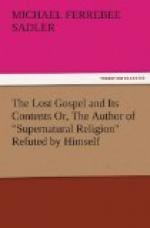We are reminded that there were numerous apocryphal Gospels then in use in the Church, and that Justin might have derived his matter from these; but, if so, how is it that he discards all the lying legends with which those Gospels team, and, with the solitary exception of the mention of the cave, confines himself to the circumstances of the synoptic narrative.
The next place respecting the Nativity shall be one from ch. c.:—
“But the Virgin Mary received faith and joy, when the angel Gabriel announced the good tidings to her that the Spirit of the Lord would come upon her, and the power of the Highest would overshadow her; wherefore also the Holy Thing begotten of her is the Son of God: and she replied, ‘Be it unto me according to Thy word.’”
Here both the words of the angel and the answer of the virgin are almost identical with the words in St. Luke’s Gospel; Justin, however, putting his account into the oblique narrative.
We will put the two side by side that the reader may compare them.
[Greek Table]
Pistin de kai charan labousa | Maria he parthenos euangelizomenou | aute Gabriel angelou, hoti pneuma | Pneuma hagion epeleusetai epi kyriou ep’ auten epeleusetai, | se, kai dynamis hypsistou kai dunamis hypsistou episkiasei | episkiasei soi, dio kai to gennomenon auten, dio kai to gennomenon | hagion klethesetai Hyios Theou. ex autes hagion estin Hyios Theou, | * * * * * apekrinato, Genoito moi kata to | Genoito moi kaia to rhema sou. rhema sou. |
Now of these words, as existing in St. Luke, the author of “Supernatural Religion” takes no notice. Was he, then, acquainted with the fact that Justin’s words in this place so closely correspond with St. Luke’s? We cannot say. We only know that he calls his readers’ particular attention to a supposed citation of the previous words of the angel Gabriel, cited in another place:—
“Behold thou shalt conceive of the Holy Ghost, and shalt bear a Son, and He shall be called the Son of the Highest, and thou shalt call His name Jesus, for He shall save His people from their sins.” (Apol. I. ch. xxxiii.)
The ordinary unprejudiced reader would say that Justin here reproduces St. Matthew and St. Luke, weaving into St. Luke’s narrative the words of the angel to St. Joseph; but our author will not allow this for a moment. He insists that Justin knew nothing, or need have known nothing, of St. Luke. He shows that the words of the angel, “He shall save his people,” &c., which seem to be introduced from St. Matthew, “are not accidentally inserted in this place, for we find that they are joined in the same manner to the address of the angel to Mary in the Protevangelium of St. James.”




